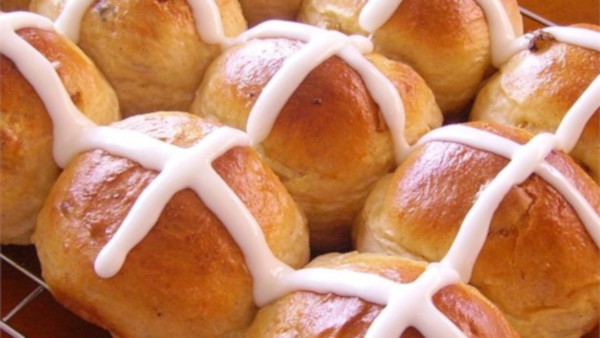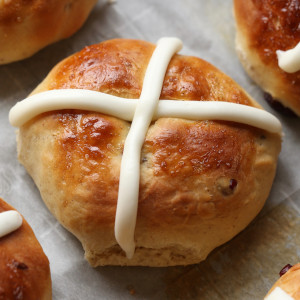Hot Cross Buns are traditionally eaten at Easter – and at no other time of the year. We all know that the white cross in the top of the brown Bun represents the cross on which Jesus Christ died. But most of us don’t know where it came from, or how the Hot Cross Bun we know today evolved…
 Perfect Hot Cross Buns – With the fancy Sugar and Milk glaze…
Perfect Hot Cross Buns – With the fancy Sugar and Milk glaze…
Legend has it that the Hot Cross Bun originated with Brother Thomas Rodcliffe, a 14th Century monk at St Albans Abbey, built in Norman times in what would become the City of St. Albans just north of what’s now Greater London. It’s said that Brother Thomas baked simple pastries to distribute to the poor on Good Friday, to remind them of the religious significance of the day, as early as 1361. His version of what he dubbed the ‘Alban Bun’ was a simple thing, made from Spices and Plain Bread Dough, with a cross cut in the top of the Bun to symbolize the crucifix.
Record show that, in the time of Queen Elizabeth I, the London Clerk of Markets decreed that Hot Cross Buns an other spiced Breads could only be sold at Easter, Christmas and at funerals. The latter allowance may have been made so mourners could get some relief from the stench of decay (there was no embalming, then) by infusing their palates with the spices.
What a difference a few hundred years makes!
The first record of the Hot Cross Bun we eat today – a soft Sweet Dough Roll sometimes including Raisins, Currants or other Preserved Fruits – appears in 1733, in Poor Robin’s Almanac, which recorded a street rhyme: “Good Friday comes this month / The old woman runs / With one-a-penny, two-a-penny Hot Cross Buns.” These Buns were probably larger than those we see today. In fact, Bread of all sorts was usually baked in small, hand-formed, dome-shaped ‘loaves’ about 4 – 5 in. / 10 – 12.5 cm in diameter – just the right portion for a meal for one person.
Steeped in superstition…
Among the superstitions associated with the Hot Cross Bun is the belief that Buns Baked on Good Friday will not spoil for the rest of the year. And at least one such bun should be kept so a morsel of it can be fed to anyone who becomes ill over the year, as a cure.
Some believe that taking a Hot Cross Bun with you on a sea voyage will keep you safe from shipwrecks. And hanging one in your kitchen will keep you safe from fire.
All these superstitions can be traced back to the Easter Story and its powerful symbolism.
Make your own…
Here is a highly-rated Hot Cross Bun Recipe you can make yourself, with a little effort and some artistry. I prefer a spicier Hot Cross Bun; I’ve used the traditional Pumpkin Pie Spices with great success. This recipe is a ‘fancy’ one, calling for a brush of Egg Wash over the top of each Bun to produce the deep brown colour and gloss. Note that the Cross is made with a simple Icing Sugar and Milk Glaze, applied after baking. Some cooks prefer to use a paste of Sugar, Flour and Water.
Enjoy your Easter holiday and be sure to enjoy Hot Cross Buns today, whether you make them yourself or pick them up at your favourite bakery!
~ Maggie J.

